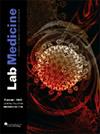创造分子氛围:第二阶段
IF 1
4区 医学
Q4 MEDICAL LABORATORY TECHNOLOGY
引用次数: 1
摘要
在决定购买哪些仪器的过程中,我们考虑了微生物部分子部的设置。与任何新检测的实施一样,我们必须考虑特定的设备要求、人员要求和工作流程问题。然而,这种新的分子气氛的形成涉及到比以往更多的细节;引入分子分析并不像其他实施方法那样简单。我完全离开了自己的舒适区,不知道从哪里开始。当我开始实地考察时,我开始了解到建立分子氛围的复杂性;这些访问让我对我需要创造的东西有了第一手的了解。这既可怕又令人兴奋——很明显,我需要大量的时间来完成这个项目。在参观各种设施时,我做了详细的笔记,并问了很多问题,包括如何创造分子气氛的一般主题和与检测本身相关的特定主题。技术人员对我的问题表示感谢,他们理解这种类型的测试对许多人来说都是新的,并且在提供他们在该领域的知识方面非常有帮助。我带着我学到的信息回来了,并开始思考我们需要在OSF圣弗朗西斯医疗中心实施的指导方针。我们的系统实验室由美国病理学家学院(CAP)认证,我们遵循临床实验室标准协会(CLSI)提出的指导方针。当时,这些人……[[1]*信函应寄给他们。电子邮件:stephanie.e.wallace{at}osfhealthcare.org [1]: #xref-corresp-1-1本文章由计算机程序翻译,如有差异,请以英文原文为准。
Creating a Molecular Atmosphere: Phase 2
We pondered the set-up of the molecular section within the Microbiology department during the process of deciding on which instruments to purchase. As with the implementation of any new assay, we had to look at specific facility requirements, personnel requirements, and workflow issues. However, more details than usual were involved with the creation of this new molecular atmosphere; bringing in molecular assays was not as simple as other implementations had been. I was completely out of my comfort zone and had no idea where to begin. As I started the site visits, I began to understand the complexity of building a molecular atmosphere; these visits gave me a first-hand look at what I needed to create. It was scary and exciting—it became evident that I would need lots of time for this project.
While visiting the various facilities, I took detailed notes and asked lots of questions encompassing the general topic of how to create a molecular atmosphere and specific topics related to the assays themselves. The technologists appreciated my questions, understanding that this type of testing was new to many, and were extremely helpful in offering their knowledge in the field.
I returned with the information I had learned and started thinking about the guidelines that we would need to implement at OSF Saint Francis Medical Center. Our system laboratory was certified by the College of American Pathologists (CAP) and we followed guidelines proposed by the Clinical Laboratory Standards Institute (CLSI). At the time, these …
[↵][1]* To whom correspondence should be addressed. E-mail: stephanie.e.wallace{at}osfhealthcare.org
[1]: #xref-corresp-1-1
求助全文
通过发布文献求助,成功后即可免费获取论文全文。
去求助
来源期刊

Labmedicine
医学-医学实验技术
CiteScore
2.50
自引率
0.00%
发文量
155
审稿时长
>12 weeks
期刊介绍:
Lab Medicine is a peer-reviewed biomedical journal published quarterly by the ASCP and Oxford University Press. The journal invites submission of manuscripts on topics related to clinical chemistry and microbiology, hematology, immunology, transfusion medicine, molecular diagnostics, cytology, histology, and laboratory administration and management. Original research, reviews, and case reports are considered for publication. Lab Medicine is indexed (under the title Laboratory Medicine) by the National Library of Medicine and is included in the PubMed database.
 求助内容:
求助内容: 应助结果提醒方式:
应助结果提醒方式:


